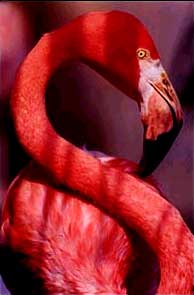A Flamboyance of Flamingos
Hurricane season arrived this week in the Atlantic and everyone living in the Caribbean Islands, Cuba, Florida, Central America and the gulf coasts of Mexico, Texas and Louisiana are once again peering nervously at weather predictions, calculating statistical charts and pondering the efficacy of existing evacuation plans..
Each year between July 1st and September 30th millions of people and animals stand squarely in the bullseye of a target range that lies north of the equator between latitude 10 and 30 degrees north and which stretches west from Africa to the Americas. Storms driven by scorching summer heat boil off the African coast and, powered by ocean wind and current head west with alarming regularity, some become killers.
The Miami Metropolitan Zoo annually finds itself on the front pages of newspapers during hurricane season with the much publicized photo of 20 or so flamingos milling about in the public lavatory where they were herded for safe keeping during Miami's 1999 encounter with Hurricane Floyd.
Since that remarkable photo zoos have increasingly been under pressure to provide disaster contingency planning for their captive charges. Caged, far from home with little resource other than an instinct for survival zoo "exhibits" are especially vulnerable to natural disaster.
Today the news is that, while staffers at Miami's zoo will remain on site during a hurricane, no actual plan to assure the animal's security has been developed.
Traditionally zoos provide concrete shelters called "night houses" for he animals. Little more than concrete bunkers these rooms provide a place out of the public areas where an animal can sleep if unnaturally and there they may be secure from harm. There are however not enough night houses for all the animals.
A check at AZA, The American Zoo and Aquarium Association, home page reveals no mention of consideration regarding the safety of caged animals during natural disasters. This is even more remarkable given their much ballyhood effort to assist resident zoo denizens at the infamous Kabul Zoo which was left decimated and rotting from neglect after the Afghanistan War.
Animals left to their own device have considerable aptitude to overcome even the most devastating natural disaster, not so with captive zoo specimens. Trapped and helpless they often fall victim to the simple fact that today's zoo standards for animal care are far short of anything like real security.

Each year between July 1st and September 30th millions of people and animals stand squarely in the bullseye of a target range that lies north of the equator between latitude 10 and 30 degrees north and which stretches west from Africa to the Americas. Storms driven by scorching summer heat boil off the African coast and, powered by ocean wind and current head west with alarming regularity, some become killers.
The Miami Metropolitan Zoo annually finds itself on the front pages of newspapers during hurricane season with the much publicized photo of 20 or so flamingos milling about in the public lavatory where they were herded for safe keeping during Miami's 1999 encounter with Hurricane Floyd.
Since that remarkable photo zoos have increasingly been under pressure to provide disaster contingency planning for their captive charges. Caged, far from home with little resource other than an instinct for survival zoo "exhibits" are especially vulnerable to natural disaster.
Today the news is that, while staffers at Miami's zoo will remain on site during a hurricane, no actual plan to assure the animal's security has been developed.
Traditionally zoos provide concrete shelters called "night houses" for he animals. Little more than concrete bunkers these rooms provide a place out of the public areas where an animal can sleep if unnaturally and there they may be secure from harm. There are however not enough night houses for all the animals.
A check at AZA, The American Zoo and Aquarium Association, home page reveals no mention of consideration regarding the safety of caged animals during natural disasters. This is even more remarkable given their much ballyhood effort to assist resident zoo denizens at the infamous Kabul Zoo which was left decimated and rotting from neglect after the Afghanistan War.
Animals left to their own device have considerable aptitude to overcome even the most devastating natural disaster, not so with captive zoo specimens. Trapped and helpless they often fall victim to the simple fact that today's zoo standards for animal care are far short of anything like real security.













0 Comments:
Post a Comment
<< Home